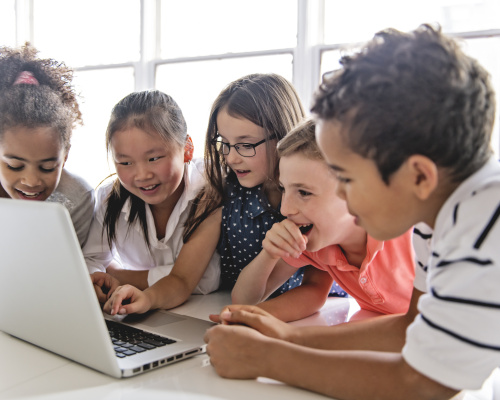Universal Design for Learning and Digital Equity
Date
With a focus on digital equity that moves beyond providing access to devices and reliable connectivity, Universal Design for Learning offers guidelines to support learners through personalization that honors each learner’s needs and strengths.
In their Driving K-12 Innovation report, The Consortium for School Networking’s (CoSN) describes digital equity as the interconnectedness of digital foundations, learning conditions, and meaningful learning opportunities. While digital equity has historically been seen as providing equitable access to technologies such as powerful devices and high-speed internet both inside and outside of school, the definition is broadening to ensure students:
- Have the knowledge and skills to use technology for learning;
- Have opportunities to interact with robust and accessible content and programs;
- Have their identities represented with and by the technologies themselves; and,
- Experience meaningful opportunities that empower themselves as learners.
It’s important to remember that even if students have access to both devices and reliable connectivity, inequities will persist if they don’t have the skills and opportunities to use the technologies effectively as learners and creators.
Opportunities to Adapt and Grow
Instead of returning to the pre-pandemic learning model, leverage the creativity, innovation, and problem-solving that educators are using to capitalize on the skills students have acquired, including those beyond content knowledge.
Learner variability is “a recognition that all students differ, and that these differences matter for learning. If you start with the assumption that there is variability among each learner, different decisions are made on how to create optimal environments and opportunities to support their learning.” Source: Digital Promise
Educators can use guidelines, like Universal Design for Learning (UDL), to design learning experiences where students direct their learning in ways that honor the variability of learners' needs and strengths including pace, pathways, strategies and how they demonstrate knowledge/skills.
With digital equity adding emphasis on supporting all learners to use tools to develop important skills, UDL can help students develop as expert learners.
“Not only do students need equitable access, but they also require equitable opportunity to develop as expert learners.” Source: Getting Smart
Districts and schools can utilize funding sources to engage in long-term strategic planning. ESSER funding can help support and create sustainable programs for the next 3-5 years and beyond.
What is Universal Design for Learning?
Universal design for learning (UDL) is a framework of guidelines for designing learning experiences so students have options for how they learn, what materials they use, and how they demonstrate their learning. UDL focuses on providing multiple means of:
- Engagement (Why)
- Representation (What)
- Action and expression (How)
The UDL guidelines address the why, what, and how of learning and strive to support expert learners who are purposeful and motivated, resourceful and knowledgeable, and strategic and goal directed. UDL views learner variability as the rule, not the exception; an opportunity to explore differences within students.
“When implemented with a lens of equity, the framework has the potential to eliminate opportunity gaps that exclude many learners, especially those who have been historically marginalized. If we want all students to have equal opportunities to learn, we have to be incredibly purposeful, proactive, and flexible. UDL creates a learning environment that is the least restrictive and most culturally responsive, trauma-informed environment for all students.” Source: Cult of Pedagogy
The Why, What, and How of UDL
The why (affective networks)
Learners differ in the ways in which they can be engaged or motivated to learn as different tools, topics, and strategies engage and inspire students in different ways.
Action: Provide options for students to build interest and commitment in learning.
Focus on:
- Building interest by sparking excitement and curiosity for learning;
- Sustaining effort by tackling challenges with focus and determination; and,
- Using self-regulation to harness the power of emotions and motivation in learning.
The what (recognition networks)
Learners differ in how they perceive and comprehend information that is presented to them as they have different background information, funds of knowledge, and access to the same language.
Action: Since learning (and its transfer) occurs when multiple representations are used, allow students to make connections within, as well as between, concepts.
Focus on:
- Providing multiple modes of perception with flexible content that doesn't depend on a single sense;
- Communicating through languages and symbols that create a shared understanding; and,
- Constructing meaning and generating new understandings through comprehension.
The how (strategic networks)
Learners differ in the ways that they navigate learning environments and express what they know and traditionally they have been asked to share their understanding in singular pathways
Action: Provide students with opportunities to explore how they act and express their learning with strategy, practice, and organization.
Focus on:
- Interacting in physical ways with accessible materials and tools;
- Expressing and communicating ideas using tools that help attain learning goals; and,
- Developing executive functioning by acting on plans to make the most out of learning.
How UDL Supports Digital Equity
UDL sends the message to students that they are more important than systems, they are more important than educators’ personal preferences, and their identity and goals are valued in a way that drives instructional decisions. UDL also helps to ensure digital equity for all students, including those with disabilities, through design that provides materials and platforms that are accessible and work with the software and hardware, such as assistive technologies, available to students.
This blog originally appeared on the K-12 Blueprint—a website of tools and resources created and curated by our team.

